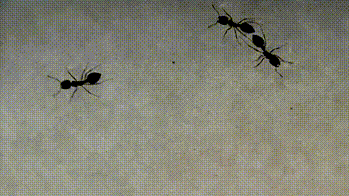Fire ants are experts in making rafts to survive floods. It would make sense to expect them to excel at finding neighboring ants on the water surface. However, we observe fire ants do random walks on the water surface, regardless of whether other ants are present or not. Even more surprisingly, when fire ants are close to each other, they kick others out of the way through this random motion rather than forming the connection. It seems that the random kicking of fire ants prevents the formation of rafts.
On the other hand, we observe ants attracting to each other through the surface tension force, just like Cheerios on the milk tend to be attracted to each other. The larger the raft, the larger the surface tension acts to attract the stray individuals. Is surface tension sufficient for the formation of the raft despite the random kicks? Do ants slow down the random kicks under certain conditions? We are currently doing experiments to find out!
Most physical materials are assembled through the balance between attractive and repulsive mechanisms. Our hypothesis puts rafts into an interesting analogy with water. Water molecules are attracted to each other through hydrogen bonds. On the other hand, temperature drives the ‘random kicks’ of the water molecules that prevent the molecules from coming too close. When the temperature is below the freezing point, the ‘random kicks’ weakens, and the attractive mechanism drives the formation of ice. I’d like to think about raft formation as the fluid to solid phase transition process!

